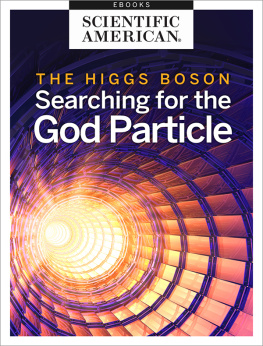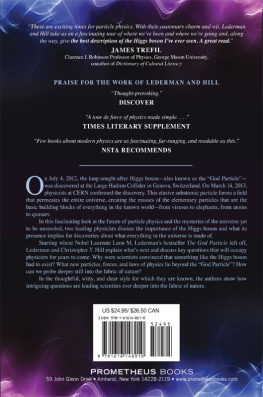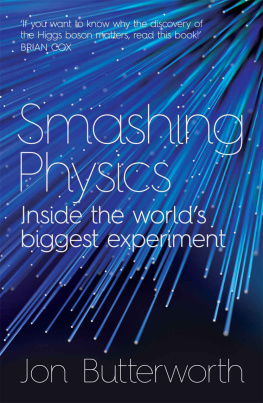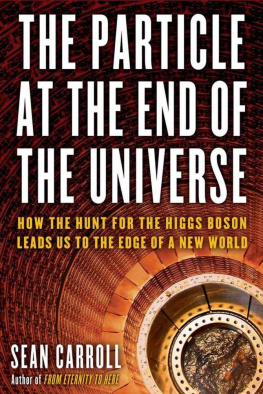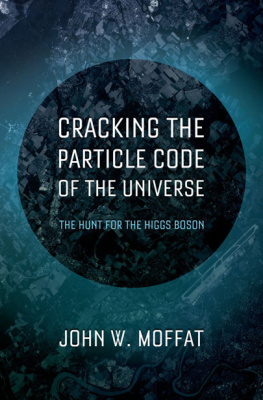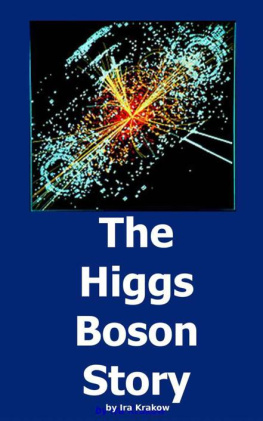James Gillies - CERN and the Higgs Boson
Here you can read online James Gillies - CERN and the Higgs Boson full text of the book (entire story) in english for free. Download pdf and epub, get meaning, cover and reviews about this ebook. year: 2018, publisher: Icon Books, genre: Science fiction. Description of the work, (preface) as well as reviews are available. Best literature library LitArk.com created for fans of good reading and offers a wide selection of genres:
Romance novel
Science fiction
Adventure
Detective
Science
History
Home and family
Prose
Art
Politics
Computer
Non-fiction
Religion
Business
Children
Humor
Choose a favorite category and find really read worthwhile books. Enjoy immersion in the world of imagination, feel the emotions of the characters or learn something new for yourself, make an fascinating discovery.
- Book:CERN and the Higgs Boson
- Author:
- Publisher:Icon Books
- Genre:
- Year:2018
- Rating:4 / 5
- Favourites:Add to favourites
- Your mark:
- 80
- 1
- 2
- 3
- 4
- 5
CERN and the Higgs Boson: summary, description and annotation
We offer to read an annotation, description, summary or preface (depends on what the author of the book "CERN and the Higgs Boson" wrote himself). If you haven't found the necessary information about the book — write in the comments, we will try to find it.
CERN and the Higgs Boson — read online for free the complete book (whole text) full work
Below is the text of the book, divided by pages. System saving the place of the last page read, allows you to conveniently read the book "CERN and the Higgs Boson" online for free, without having to search again every time where you left off. Put a bookmark, and you can go to the page where you finished reading at any time.
Font size:
Interval:
Bookmark:
James Gillies began his career at CERN as a graduate student in 1986. After eight years in research and a brief stint at the British Council in Paris, he joined the laboratorys communications group in 1995, heading the group from 2003 to 2015. He is now a member of CERNs strategic planning and evaluation unit.
This book gives just a glimpse of the fantastic journey of discovery that is particle physics. It would be impossible in a book of this kind to tell the whole story, with all its twists and turns, dead ends and new beginnings. As a result, there are whole areas of physics, giants of the field, technological advances and major laboratories that are missing or only hinted at. Instead, I have focused on the electroweak physics to which CERN has contributed so much over the years, and included just the physics necessary to tell the story of the Higgs. I have tried to give an idea of how extraordinary it is that human intellect has delivered the theories and the machines that allow us to understand the workings of the universe at such an intricate and intimate level. There are those who say that science of this kind diminishes natures beauty. On this point, I can only concur with the great Richard Feynman who offered the opposite view: science can only add to our sense of wonder. I hope that I have managed to convey some of that wonder in these pages.
I would like to thank Austin Ball, Stan Bentvelsen, Tiziano Camporesi, Dave Charlton, Jonathan Drakeford, Rolf Heuer, John Krige, Mike Lamont, Michelangelo Mangano, John Osborne and David Townsend, all of whom know much of this story far better than I, and generously gave up their time to read and improve the draft. Any remaining errors are my own. My thanks also go to series editor Brian Clegg, along with Duncan Heath and Robert Sharman at Icon Books for their many constructive comments and sensitive editing of the manuscript. Finally, I would like to thank my wonderful family for their patience and support.
It was mid-afternoon when the phone rang. I was in the garden searching among weeds for the vegetables Id planted a couple of months earlier. What Ive just seen is not going away, said the voice on the other end. It was Austin Ball, an old friend from the days when we were both working on the OPAL experiment at CERN, the European particle physics laboratory near Geneva. Earlier that day hed seen the results of his experiments search for the elusive Higgs particle. Hed been in the room when the physicists working on one of the big LHC (Large Hadron Collider) experiments had taken their first look at their results, and what they had seen had set hearts racing.
Such moments are few and far between: occasions on which a scientist, or in this case a roomful of scientists, can be the first to know something completely new to humankind. What I would have given to be in that room but Id traded my research career 20 years ago for a job in CERNs public communications team. Austin had thought long and hard before calling me, and for good reason: new results are closely guarded secrets until the experimenters are absolutely sure they are ready to go public. I felt honoured to be trusted enough to be brought into this privileged inner circle; and now, sworn to secrecy, I knew we had a job to do. We had to get ready for the biggest announcement in the laboratorys history. And we had to do it with the utmost discretion.
The Large Hadron Collider is CERNs flagship research instrument. It had risen to notoriety some four years earlier for all kinds of reasons. As the worlds largest scientific instrument, with a price tag to match, and host to global collaborations involving thousands of scientists and engineers of around 100 nationalities, it had grabbed the popular imagination. For many, CERNs quest to understand the weird and wonderful universe we inhabit represented the true spirit of humanity; a model of what people can do when they put aside their differences and work together to achieve a common goal. To others, however, it was irresponsible, dangerous, or even redolent of the biblical story of Babel: an arrogant affront to the divine.
Whatever people thought, the net result was that the eyes of the world were on CERN, and when the time came to announce this particular result, it would not be a quiet affair in front of an exclusive audience of physicists in the labs main auditorium. This would be much bigger.
Timescales are long in particle physics. The LHC was first imagined in the late 1970s, and one of its main research goals went back even further, to 1964. That was the year that Robert Brout and Franois Englert, and independently Peter Higgs, published papers in the journal Physical Review Letters proposing a mechanism that would give mass to fundamental particles. Why should anyone care about that? Because we, and everything we can see in the universe, are made of fundamental particles, and without mass those particles would be unable to form anything solid. In other words, we would not exist.
From the early 1960s, understanding mass ranked among the most pressing of riddles in fundamental physics, and it would take almost half a century to solve. Thankfully, physicists are usually blessed with a great deal of patience. Before any experiments would be ready to deliver the experimental evidence to confirm the idea of Brout, Englert and Higgs, a decade of theoretical work would be needed. It would be several decades before technology delivered the instruments that would eventually crack the enigma.
Research and development for the LHC began in the mid-1980s, while experimental collaborations started to form in the early 90s. The project was fully approved by 1996, and construction began soon after. By 2008, the machine was ready to go, and under the eyes of the global media, a beam of particles was circulated for the first time on 10 September 2008. It was a day of great excitement at CERN. Just another day at the office, eh? said LHC project leader Lyn Evans as I headed for home at the end of the day. But the elation was short lived. Just nine days later, the LHC suffered a setback from which it would take a year to recover: a helium leak led to extensive damage to the machine. Meanwhile, at Fermilab in the United States, another remarkable particle collider, the Tevatron, a venerable machine first switched on in 1985, was limbering up for one last push to discover the particle that had come to be known as the Higgs. Discovering the Higgs particle would bring confirmation that Brout, Englert and Higgs were right. The race was on.
Although particle theory was very clear that a mechanism for mass was needed, and would have to appear at the particle collision energies of the LHC, there was one key feature of the Higgs that it did not predict: the particles mass. It could well be in range of the Tevatron nobody knew. But if the Higgs existed at all, it would definitely be in range of the LHC. The currencies of particle physics are mass and energy, with the exchange rate being the speed of light squared. Thats what Einsteins famous equation E=mc2 tells us, and its why particle accelerators concentrate energy in a tiny space, converting it to mass in the form of new particles. The higher the energy of the accelerator, the higher the mass of the particles that can be produced, and the LHC was designed for a collision energy some seven times higher than that of the Tevatron.
By the end of 2009, the LHC was back in the race and with a vengeance. Records rapidly fell, and on 30 March 2010, data collection began. The days of sudden realisations leading to Eureka! moments in fundamental physics research are long gone. In modern particle physics research, discovery often comes through a painstaking analysis of vast quantities of data, looking for subtle signals that known physics cant explain. Like everything else in modern research, Eureka requires patience.
Font size:
Interval:
Bookmark:
Similar books «CERN and the Higgs Boson»
Look at similar books to CERN and the Higgs Boson. We have selected literature similar in name and meaning in the hope of providing readers with more options to find new, interesting, not yet read works.
Discussion, reviews of the book CERN and the Higgs Boson and just readers' own opinions. Leave your comments, write what you think about the work, its meaning or the main characters. Specify what exactly you liked and what you didn't like, and why you think so.


